Caracas’ Public Museums: The Struggle for Survival
Although a visit to the Bellas Artes cultural circuit isn’t for the nostalgic, not everything is lost and there's a lot of its former glory still there.


Photo: Tony Frangie Mawad
On a whim, I decided to visit the museums in Caracas.
Among the bamboo shadows and the ruins of the Viasa Tower against the blue sky, I found myself in front of the Adam and Eve sculptures with barloventeño facial features that Francisco Narváez chiselled for the Museo de Ciencia façade.
I don’t have enough to go by to compare it to how it was in the past. I was born in the late ‘90s and, perhaps as a consequence of the time I live in, I’ve known Caracas in a reduced and fragmented way.
I vaguely remember my only visit as a child to the Museo de Ciencia and the old Galería de Arte Nacional. I remember the stuffed giraffe and antelopes, and Miranda en la Carraca, as well as the water lilies and koi fish under a willow tree’s shadow. In spite of my admiration, I only knew the Museo de Arte Contemporáneo through photobooks and Diego Arroyo Gil’s La señora Ímber. The public museums in Caracas were a new world to me.
The Shadow of the Museo de Ciencias
As I go through the tropicalized Art Déco façade of the Museo de Ciencias (opened in 1940), it’s the huge lettering in worn down golden and red mosaics that welcome you to a place with a cold soul and barely lit by white lights. In a corner, a bored receptionist sits on a green desk, a TV in front of her.
There’s not much to see. The inner yard is lined with hallways and stuffed animal heads that are hung randomly with no name tags. One of the walls has a school-like white piece of cardboard with a rhinoceros skeleton drawn on it. Red ropes and a sign saying “Room closed for maintenance” prevent visitors from entering another area.
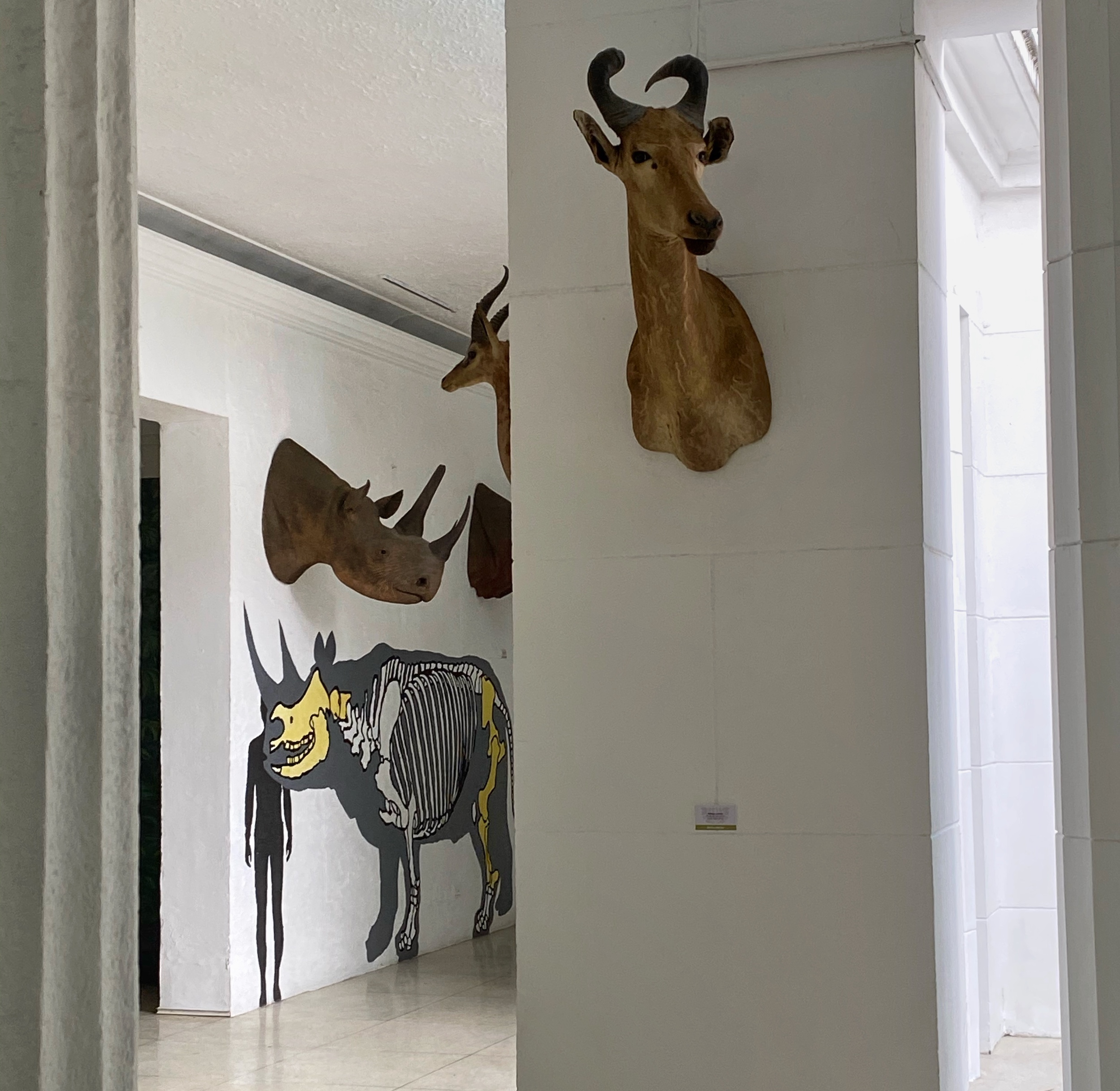
“The inner yard is lined with hallways and stuffed animal heads that are hung randomly with no name tags.” Photo by Tony Frangie Mawad.
From my side of the red ropes, I can see a huge fossil of the prehistoric alligator Purussaurus—excavated in Falcón—and a stuffed harpy eagle that used to live in the Parque del Este. There’s also a bear close to room number 3, that’s also “under maintenance” and it’s filled with cables, vacuum cleaners, machines and mock-ups. The Museo de Ciencias is in deep contrast to its Instagram account, which is taken care of and filled with nostalgic throwbacks to the museum’s golden era.
In room number 4, you’ll find the African ethnographic collection. It’s difficult to appreciate the masks, spears and statues identified with small white papers under such bad lighting. A sign says that Africa is “of huge interest to China and the United States because of the possibilities of exploiting its hydrocarbon resources”. I remember that, in 2009, the Viceminister of Culture, José Manuel Rodríguez, suggested returning the African, Egyptian and Chinese art collections back to their country of origin.
Bellas Artes: Afloat Against All Odds
Its low attendance is expected: it’s only the first week of the year. Even so, it’s amazing how empty the Museo de Bellas Artes is (as well as the other public museums in Caracas). With the exception of an older couple, no one is walking around its hallways. Most of the staff are on holiday leave, including the security guards. It seems like there are no security cameras.
The only open exhibits are those in the neoclassical building (where up until a few years ago, the National Art Gallery used to be) and the pre-modern European art floor, in the modern building. Both buildings, connected, were designed by Carlos Raúl Villanueva; the neoclassical complex was built between 1935 and 1936, and the modern building between 1972 and 1973. The former opened its doors in 1936, the latter in 1976.
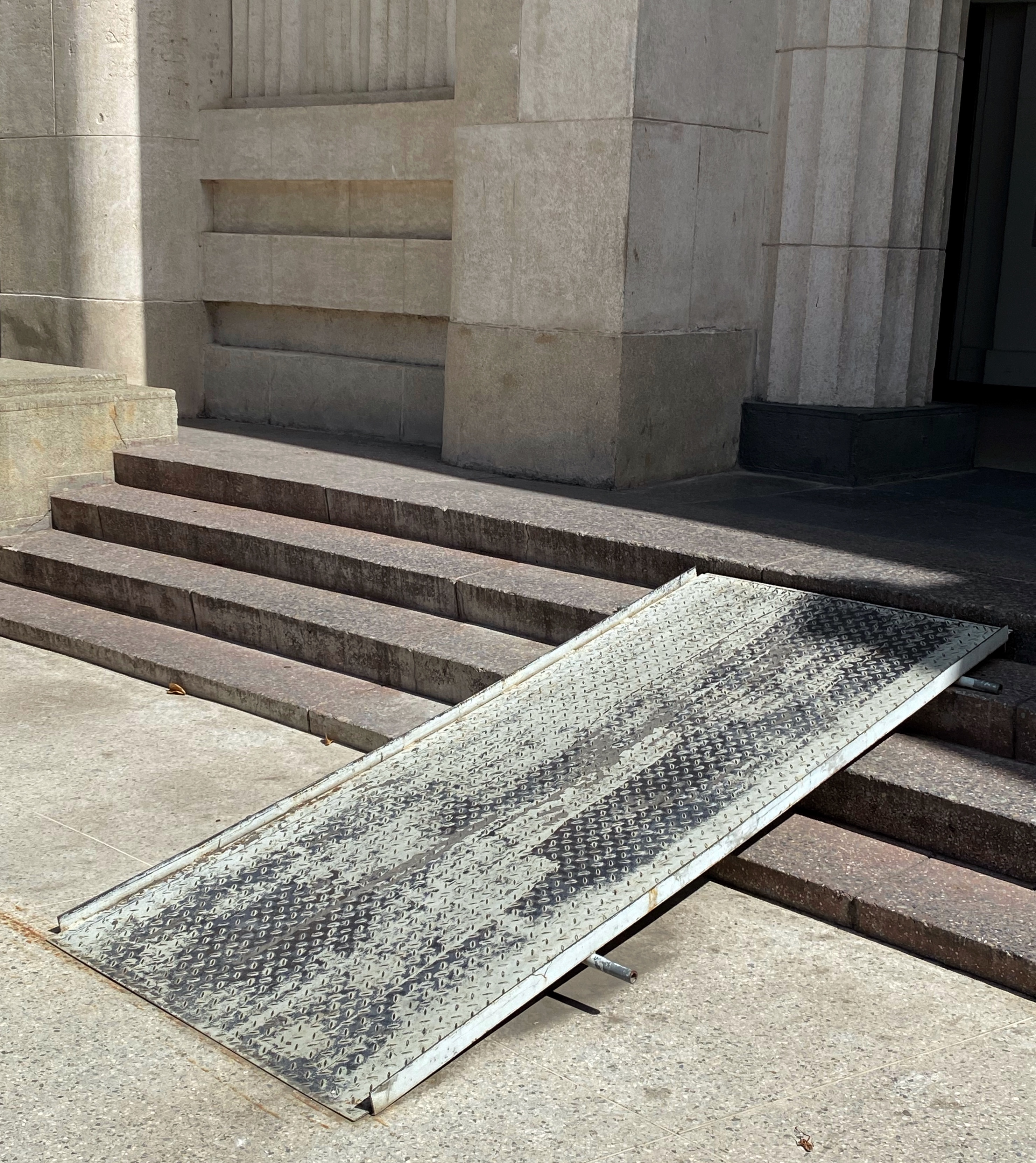
“Although a broken-down, metal ramp is placed on top of the stairs leading to the imposing entrance of the Museo de Bellas Artes, and the Narváez frescos are crossed by long cracks, the neoclassical building is in pretty good shape.” Photo by Tony Frangie Mawad.
Although a broken-down, metal ramp is placed on top of the stairs leading to the imposing entrance of the Museo de Bellas Artes, and the Narváez frescos are crossed by long cracks, the neoclassical building is in pretty good shape. The grass and the willow from that Arcadian garden are still green and the pond is filled with koi fish, water lilies, and dragonflies. The sculptures, among them one of El Ávila by Calder from the 1950s, all seem intact, but some of the artwork lacks identification. On the walls that line the corridors in the outer yard, you can see dirt smudges and stains that appear to be mud. Inside, while the ceramic floor has deep stains, you’ll find an exhibit—well displayed and with air conditioning—of concept photography by Claudio Perna.
I head to the modern complex that houses the European, Chinese and Egyptian collections. According to several publications, the museum keeps nine collections and almost six thousand works of art. The hallways connecting both buildings has parts of brick wall and concrete exposed, and the gift shop is broken glass, empty shelves and trivial figurines that include Frida Kahlo. There’s absolutely nothing, not a book or a t-shirt, that mentions the M.B.A.
From the balconies, I can see small lettering made from clear tubes. They were once neon tubing and beamed with colored lights. It’s all that’s left of the Humboldt’s Range, by American concept artist Joseph Kosuth, made for the museum as a temporary exhibit. In front, underneath Josep Guinovart’s work Las hojas del árbol caído, there are flyers and plastic coffee cups that people throw away and no one cleans up.
A friend tells me that the museum’s vaults are located on the upper floors, to protect the artwork and drawings from humidity. The M.B.A.’s architecture makes for a perfect microclimate that allows them to be preserved over there.
As I walk into the European collection—the only one that’s open to the public that day—I can see madonnas, kings, princesses and depictions of Christ by Flemish, Italian, French and Spanish artists. I can also see drawings by Toulouse-Lautrec and they tell me that the museum has a Duchamp. They also have a complete set, although not all of it on display, of Los caprichos by Goya. The paintings are well lit, although some are hung on a forest green wall. Why that color? It’s probably the only one they could afford with the state’s budget.
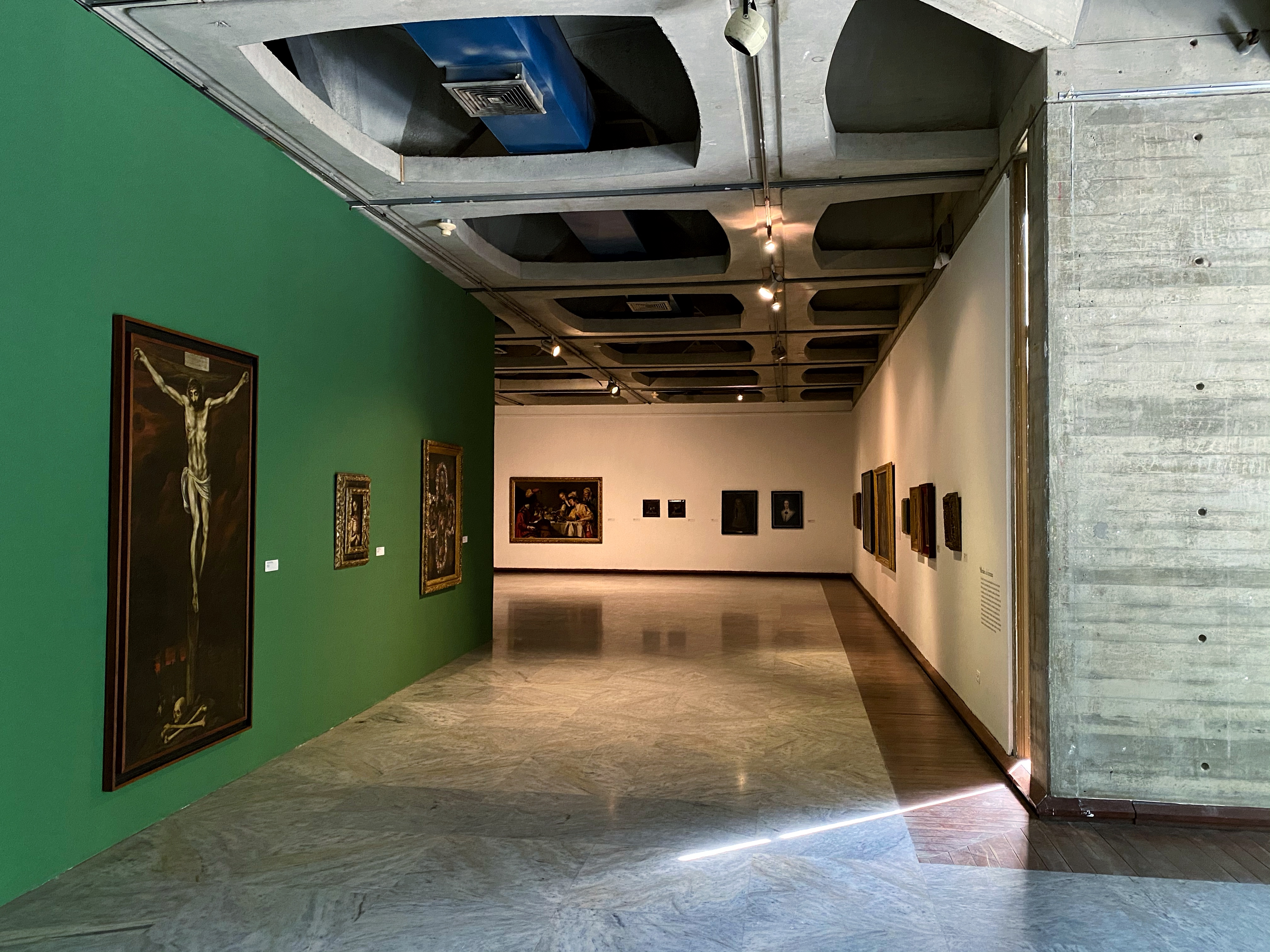
“The paintings are well lit, although some are hung on a forest green wall. Why that color?” Photo by: Tony Frangie Mawad.
My friend, who has worked at the M.B.A. for years, tells me that they “can’t buy anything” with that budget because “hyperinflation swallows any amount”. In his opinion, museums are institutions that “need alliances with the private sector” but that “unfortunately, the polarizing politics have affected the way all sectors participate”, because “sometimes the private industries don’t want to” and “sometimes the Ministry, from the top, knocks down any alliance”. However, “the plan to do things with the private industry and embassies has been recovered”. In fact, in 2018 the M.B.A. was able to put up the permanent exhibits again, thanks to the sponsorship of the French-Venezuelan petrochemical company Total Oil and Gas Venezuela.
Now, the M.B.A. is working with the Swiss Embassy to develop an exhibit to open mid-year.
Galería de Arte Nacional: An Oasis Among Hawkers
Outside the Galería de Arte Nacional, the square is filled with vendors selling lycra clothes, cell phone credit refills, and reggaeton music CDs. I think of desecrated spaces, of Jesus Christ kicking out the merchants from Temple. In the distance, the skyline is interrupted by a Misión Vivienda building: an urban aberration, since it disrupted the plan for a cultural circuit where the square was supposed to be connected to the Bellas Artes subway station. This plan, executed in the ‘70s and ‘80s, was never finished and the empty spaces that were used for offices were turned into Misión Vivienda buildings, Abastos Bicentenario and other constructions by the “revolution”.
The Galería de Arte Nacional is a strange place: the project dates to 1988, but for a very long time it was paused. It was taken up and finished (in 2006) by architect Carlos Gómez de Llarena, the same person who designed the Centro San Ignacio shopping center and the Torre Europa. Its clean concrete façade and granite floors—evoking a train station, like a wink to the European travels by the Venezuelan masters—exhales novelty and glow in spite of its dated brutalist style, typical of the Luis Herrera Campins era. It’s one of Latin America’s largest museums, housing a collection of almost seven thousand Venezuelan works of art.
The G.A.N. is the crown jewel: immaculate, conditioned, with modern amenities, proper identification for the artwork and security cameras. With the exception of one wall that has a lot of paintings (including La joven madre by Arturo Michelena), the museum doesn’t have any problems regarding lighting. In spite of this, the wall lacks the information to guide the visitor on the context and meaning of the artwork. Near the entrance—between Michelenas, Toros, and Trompiz—I find myself among the grandeur of Miranda en la Carraca. Then, for an instant, I’m a school boy once again.
Humidity at the Museo de Arte Contemporáneo
Finally, I reach the Museo de Arte Contemporáneo, whose concrete façade reads “Armando Reverón” since 2016—replacing the “Sofía Ímber” it sported from 1990 to 2006. Like other museums, most of the staff is still away on vacations and there are no security guards or cameras to be seen; the reception, with a wonderful Soto behind it, is empty. There are few visitors.
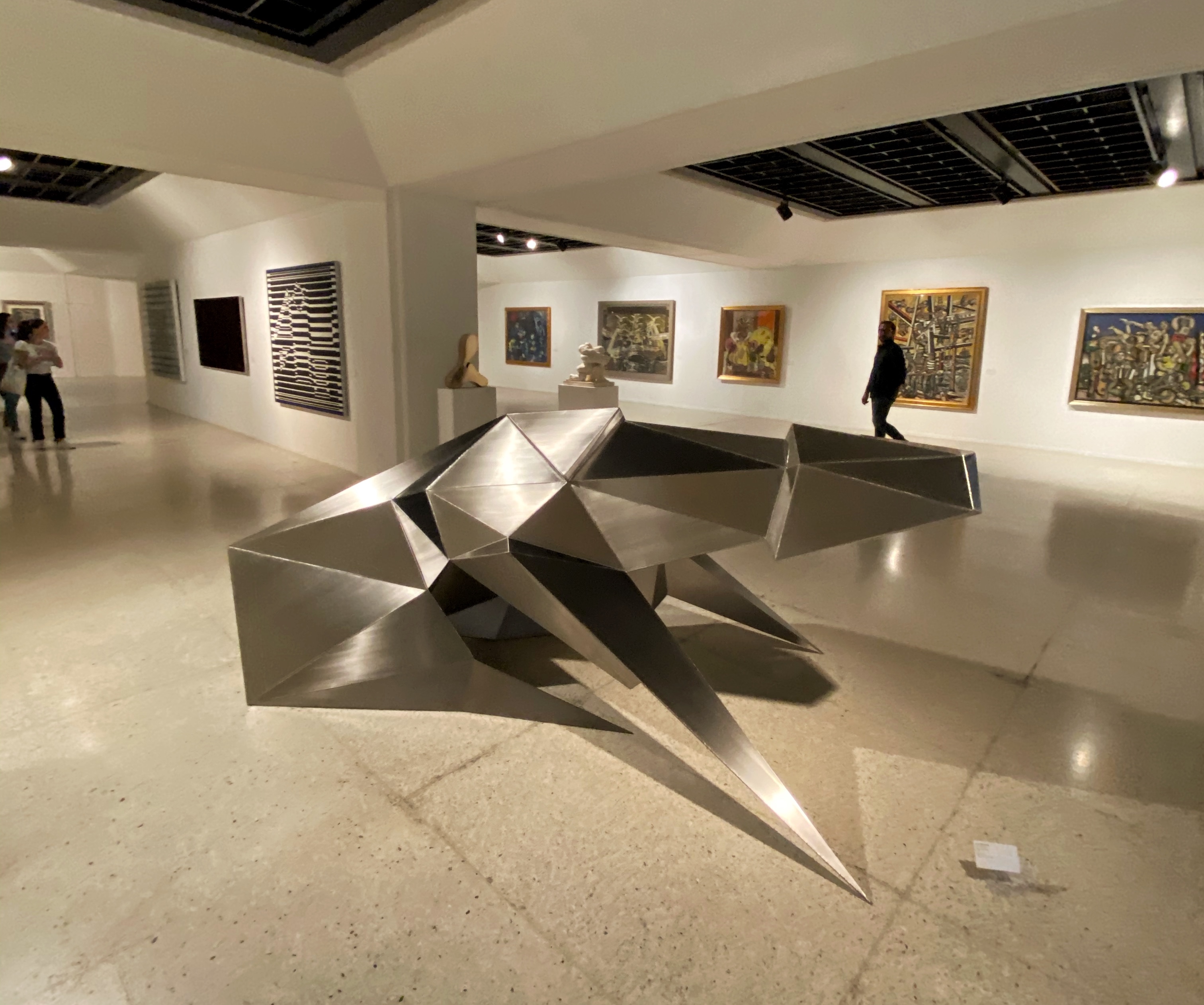
“Part of the wooden propeller of Marisol’s airplane has rotten, but most of the art is well lit and in good condition.” Photo by Tony Frangie Mawad.
It smells like humidity. The ceiling above a hanging artwork of Gego is bloated and stained. A similar situation occurs with the floor in front of a long wall of green and white by Soto. Humidity has also rusted a portion of the golden refrigeration pipes, leaving turquoise stains. Part of the wooden propeller of Marisol’s airplane has rotten, but most of the art is well lit and in good condition; it’s all a visual spectacle: Miró, Arp, Monet, Picasso, Gego, Cruz Diez, Soto, Bacon, Mondrian, Warhol and many others. There are bibliographic sources that say that the museum houses around four thousand works of art, among them an entire collection of Picasso’s graphic series Suite Vollard (one of the very few in the world) and its own The Thinker by Renoir. Outside, I can see from the windows a Gego whose strings are brimming with lichen and several sculptures on dried out fountains are covered in graffiti. My friend explains that those sculptures are property of the Parque Central towers and not the M.A.C.
I think about Sofía Imber’s last visit to the museum. “This is no longer a museum, but a corpse,” she told writer Diego Arroyo Gil, “it’s pointless to have a clean museum and have the artwork on display, but no visitors. The museum lives for the people.”
Among the colorful and abstract paintings, I find the famous Odalisca de pantalones rojos by Henri Matisse: stolen from the museum and found by the FBI at a Miami Beach hotel in 2014, then returned to Caracas. I enquire about the copy and they tell me that it was destroyed. I also ask about the rumours that the collection had been looted.
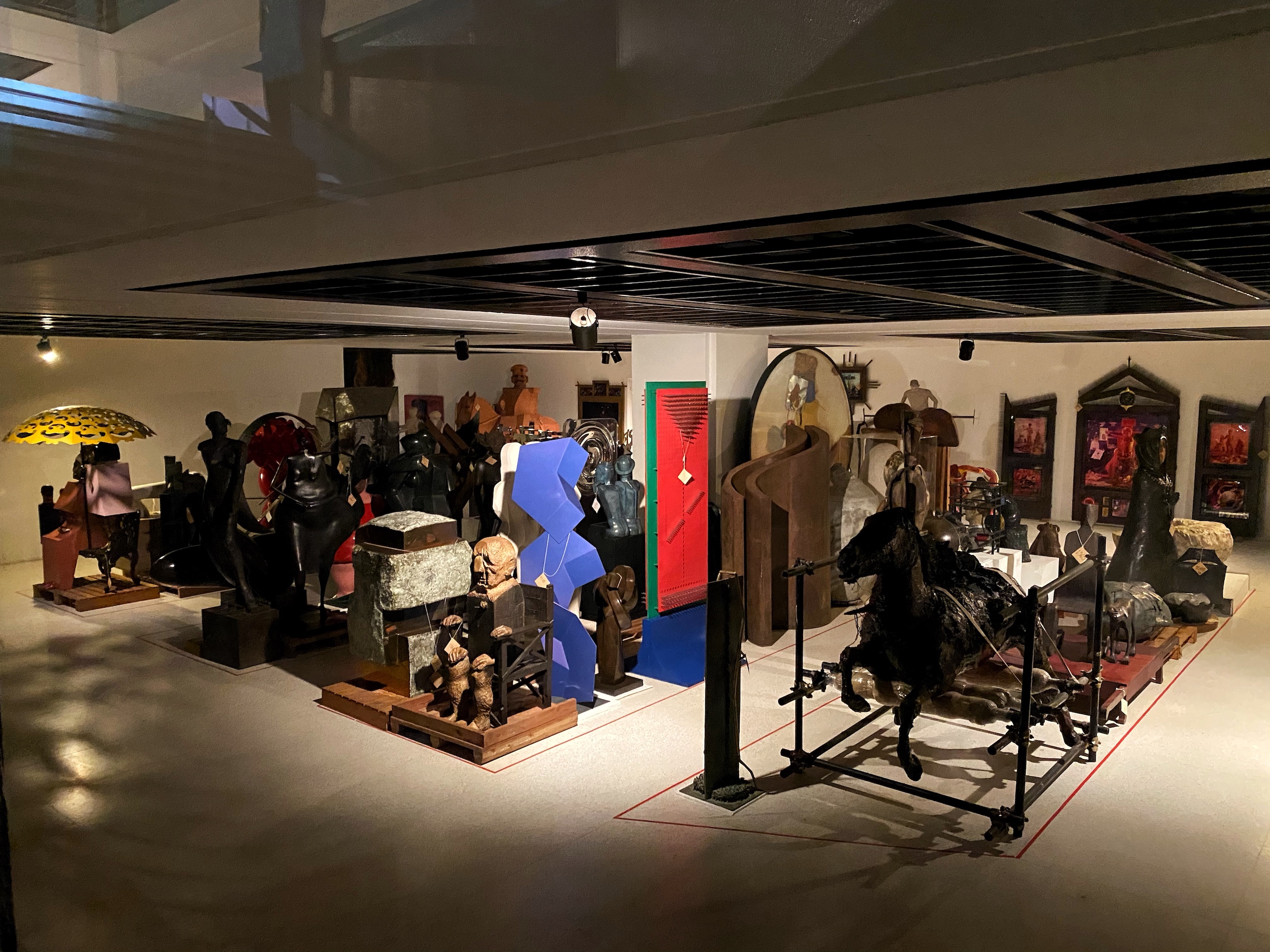
“My friend explains that those were pieces that had to be removed from the vaults. Humidity kicked them out.” Photo by Tony Frangie Mawad.
My friend tells me that the collections can be consulted by visitors “through their registration equipment” and usually the staff in charge of cultural heritage is permanent and not “given positions by government in charge”. Any theft, he claims, would’ve been reported publicly by the staff members (a lot of them work in the museum since it was under Imber’s charge) and the Interpol would’ve been notified. In fact, protocol states that no one can be alone in the vaults and only the registration team can enter, they keep the keys under custody, and are “sealed and they can’t be used; not even by the directors that are the top authority in the museum.” Furthermore, they perform a vault inventory every year, they check the artwork and they write reports.
He also explains that the Odalisca seems to have been stolen in Madrid, during an exhibit that lasted for three years and that it coincided with Sofía Ímber’s dismissal, and the inconvenience was the loss of the inventory during the chaos after she was fired. In fact, they had to re-do it from the catalogues and publications from the M.A.C. “The situation can be the complete opposite in banks, government houses, and public institutions,” he says. This was evidenced in the stolen artwork from the residence of the Venezuelan Ambassador in Washington D.C.
On the ground floor, I stumble upon the neo folkloric exhibit Color Profano, by David González. Most of the Venezuelan art that’s currently displayed in museums is shamelessly nationalistic or pamphleteer, and in today’s M.A.C. (where a year ago the exhibit Comrade Picasso showed his militancy in communism) there’s no room for artwork such as Pensamiento Único by Nelson Garrido or CEDJA and Testimonios by Armando Ruiz, crudely political and anti-establishment like much of Venezuelan art is these days.
I go down the stairs and I see a room with glass walls that shows tens of rows of works of art. I can identify the work of Narváez and Nelson Garrido, but I struggle with the rest. My friend explains that those were pieces that had to be removed from the vaults. Humidity kicked them out.
Caracas Chronicles is 100% reader-supported.
We’ve been able to hang on for 21 years in one of the craziest media landscapes in the world. We’ve seen different media outlets in Venezuela (and abroad) closing shop, something we’re looking to avoid at all costs. Your collaboration goes a long way in helping us weather the storm.
Donate



